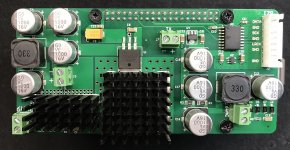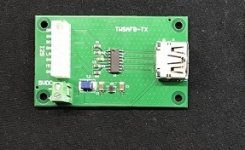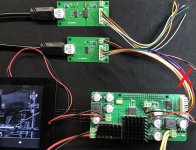They look very good Andrea. One question, is there any possibility that finished boards can be fed DC instead of AC?
You should remove yourself all the rectifier diodes and the LC filters.
Then you should provide two separate 7VDC rails.
I believe it does not worth.
Then you should provide two separate 7VDC rails.
I believe it does not worth.
TWSAFB-RPI Raspberry power supply & isolated I2S
5V Linear regulator to supply RPI and SSD hard disk
5V connector to supply the official 7" touch screen
5V independent linear regulator to supply I2S LVDS transmitter
Galvanic isolated I2S output
Board size: 117mm x 56mm
Board options: finished and semi-finished
Note: supplied without raw materials to stack it onto the RPI
5V Linear regulator to supply RPI and SSD hard disk
5V connector to supply the official 7" touch screen
5V independent linear regulator to supply I2S LVDS transmitter
Galvanic isolated I2S output
Board size: 117mm x 56mm
Board options: finished and semi-finished
Note: supplied without raw materials to stack it onto the RPI
Attachments
TWSAFB-TX LVDS transmitter I2S over HDMI
I2S CMOS input
I2S LVDS output
3V3 low noise regulator on board
5V output to supply receiver board
Board size: 64mm x 38mm
Board options: finished and semi-finished
Note: TWSAFB-RPI provides 5V power supply to this board
I2S CMOS input
I2S LVDS output
3V3 low noise regulator on board
5V output to supply receiver board
Board size: 64mm x 38mm
Board options: finished and semi-finished
Note: TWSAFB-RPI provides 5V power supply to this board
Attachments
Last edited:
TWSAFB-TX LVDS receiver I2S over HDMI
I2S LVDS input
I2S CMOS output
2 x 3V3 low noise regulator on board
5V power supply from transmitter board (non isolated section)
Connector for independent 5V power supply (isolated section)
Galvanic isolated I2S output
Board size: 82mm x 38mm
Board options: finished and semi-finished
Note: TWSAFB-LT FIFO buffer provides 5V power supply to this board
I2S LVDS input
I2S CMOS output
2 x 3V3 low noise regulator on board
5V power supply from transmitter board (non isolated section)
Connector for independent 5V power supply (isolated section)
Galvanic isolated I2S output
Board size: 82mm x 38mm
Board options: finished and semi-finished
Note: TWSAFB-LT FIFO buffer provides 5V power supply to this board
Attachments
It is likely that the oscillators will still be available to buy when the lite FIFO/DAC is announced/released?
I chose to buy 22Mhz osc as it would be more flexible (e.g driving an XMOS interface or using FIFO with DACs that require higher clk freq.) but If I ending up buying the FIFO+DAC (which requires more info to make a decision on) this will gain nothing and will have wasted much clock performance for the same cost...
I have to avoid doublers due to increased build complexity and cost, and the fact they will be completely wasted if using the FIFO+DAC.
I chose to buy 22Mhz osc as it would be more flexible (e.g driving an XMOS interface or using FIFO with DACs that require higher clk freq.) but If I ending up buying the FIFO+DAC (which requires more info to make a decision on) this will gain nothing and will have wasted much clock performance for the same cost...
I have to avoid doublers due to increased build complexity and cost, and the fact they will be completely wasted if using the FIFO+DAC.
I will also include the oscillators in the FIFO/DAC future GB, but keep in mind that there will be always the same problem of the MOQ to be met.
Anyway, both our new discrete DACs (Lite and Top versions) will only work with 5.6448 and 6.144 MHz.
And since they use a custom protocol both will only work with the new FIFO (Lite and Top versions).
Anyway, both our new discrete DACs (Lite and Top versions) will only work with 5.6448 and 6.144 MHz.
And since they use a custom protocol both will only work with the new FIFO (Lite and Top versions).
Ok, that is surprise.
You gave this answer a while ago: https://www.diyaudio.com/forums/dig...itter-crystal-oscillator-238.html#post6293382
Things have changed since then I suppose...
This decision has just gotten much tougher.
Maybe 22MHz MOQ is not met anyway, that is a good excuse to choose 5.6Mhz now
🙂
I thought of leaving choice between doublers or DAC for 5.6MHz till next GB, but maybe doublers MOQ wont be met that time round since those interested in the DAC wont need them...
You gave this answer a while ago: https://www.diyaudio.com/forums/dig...itter-crystal-oscillator-238.html#post6293382
Things have changed since then I suppose...
This decision has just gotten much tougher.
Maybe 22MHz MOQ is not met anyway, that is a good excuse to choose 5.6Mhz now
🙂
I thought of leaving choice between doublers or DAC for 5.6MHz till next GB, but maybe doublers MOQ wont be met that time round since those interested in the DAC wont need them...
Last edited:
You are right, the new discrete DAC Lite will also work with 11/12 and 22/24 MHz, while the top version of the discrete DAC will only work with 5/6 MHz.
Anyway, as I said several times, there is no reason to choose higher frequencies than you really need because the phase noise of the oscillator is inevitably worse.
Anyway, as I said several times, there is no reason to choose higher frequencies than you really need because the phase noise of the oscillator is inevitably worse.
Thats just an illusion or a very poor system in the end of that chain... I'm absolutely positive that with andreas solution in place, you wont hear any difference when changing the things you mention.
//
Hi, TNT
Curious, do you believe the same about the soekris FIFO implementation?
IME the soekris was fairly resistant to source interference/jitter but definitely not 100% transparent, granted this was the dam1121... dam1021 has isolation I think, probably a better comparison.
Also, Sabre ASRC is far from transparent IME, not sure how that compares (again not isolated).
Last edited:
Hi, TNT
Curious, do you believe the same about the soekris FIFO implementation?
IME the soekris was fairly resistant to source interference/jitter but definitely not 100% transparent, granted this was the dam1121... dam1021 has isolation I think, probably a better comparison.
Also, Sabre ASRC is far from transparent IME, not sure how that compares (again not isolated).
No, because I have strong indications on that the DAM FiFo on both 1121 ans 1021 using i2s / opto is not working as efficient as it could due to that the DAC is, apparently, optimised for Video/Cinema/TV watching so the delays must be kept down.
I don't think Andrea will do that design choice so I feel pretty confident, given hes rigor and skill in designing clocks etc., that it will isolate very efficient. We will see.
//
Hi Andrea,
When is the deadline to submit the order for the groupbuy?
Thanks
The GB has been just started so I believe it will remain open at least a pair of weeks.
No, because I have strong indications on that the DAM FiFo on both 1121 ans 1021 using i2s / opto is not working as efficient as it could due to that the DAC is, apparently, optimised for Video/Cinema/TV watching so the delays must be kept down.
I don't think Andrea will do that design choice so I feel pretty confident, given hes rigor and skill in designing clocks etc., that it will isolate very efficient. We will see.
//
Ok, thank you for the insight
I hope so too
Hi Andrea! Would it be possible to connect the I2S pins from the source (UP2 in my case) directly to the TWSAFB-TX? (<->TWSAFB-RX<->I2S recloker)
I understand that possibly loosing the first isolation could be a problem, but there is also isolation in RX side...
Should I use any isolator before TX for best performance?
Thank you very much for taking the necessary time to answer these questions!🙂🙂
I understand that possibly loosing the first isolation could be a problem, but there is also isolation in RX side...
Should I use any isolator before TX for best performance?
Thank you very much for taking the necessary time to answer these questions!🙂🙂
Based on the images of prototype FIFO I think there will be another I2S isolator board that will be intended for connecting any I2S source, the RX and TX boards will just be part of the Rpi setup.Hi Andrea! Would it be possible to connect the I2S pins from the source (UP2 in my case) directly to the TWSAFB-TX? (<->TWSAFB-RX<->I2S recloker)
I understand that possibly loosing the first isolation could be a problem, but there is also isolation in RX side...
Should I use any isolator before TX for best performance?
Thank you very much for taking the necessary time to answer these questions!🙂🙂
I cant find the photos in this thread, I dont remember where it posted.
Last edited:
Hi Andrea! Would it be possible to connect the I2S pins from the source (UP2 in my case) directly to the TWSAFB-TX? (<->TWSAFB-RX<->I2S recloker)
I understand that possibly loosing the first isolation could be a problem, but there is also isolation in RX side...
Should I use any isolator before TX for best performance?
Thank you very much for taking the necessary time to answer these questions!🙂🙂
Yes, you can use the TWSAFB-TX to connect to whatever source you want.
Anyway there is an isolator on the receiver board TWSAFB-RX.
You can simply use a non terminated cable and solder the I2S wires to your source as in the attached picture.
Attachments
- Home
- Source & Line
- Digital Line Level
- The Well synchronized asynchronous FIFO buffer - Slaved I2S reclocker



